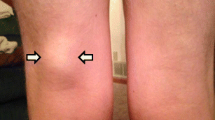Abstract
Muscle herniation can be defined as protrusion of a portion of muscle through an acquired or congenital defect of enclosing fascia. Although it is usually a cosmetic problem, it can lead to local pain and tenderness after prolonged exertion. In this report, we present a case of flexor digitorum superficialis muscle herniation in a 58-year-old man. The radiographic, ultrasonographic and magnetic resonance imaging findings are described with dynamic examination, permitting demonstration of muscle herniation through the fascial defect during muscle contraction.



Similar content being viewed by others
References
Simon HE, Sachel HA. Muscle hernias of the leg. Am J Surg 1945; 67:87–97.
Wolfort FG, Molvang LC, Filtzer HS. Anterior tibial compartment syndrome following muscle hernia repair. Arch Surg 1973; 106:97–99.
Hartzell JB. The use of living fascia transplant to repair a hernia of the tibialis anticus muscle. JAMA 1936; 107:492–493.
Bloem JJ. The treatment of muscle hernias by fascial splitting. J Plast Surg 1976; 29:291.
Zeiss J, Nabil AE, Woldenberg LS. Magnetic resonance imaging in the diagnosis of anterior tibialis muscle herniation. Clin Orthop 1989; 244:249–253.
Bianchi S, Abdelwahab IF, Mazzola CG, Ricci G, Damiani S. Sonographic examination of muscle herniation J Ultrasound Med 1995; 14:357–360.
Harrington AC, Mellete JR Jr. Herniations of the anterior tibialis muscle: case report and review of the literature. J Am Acad Dermatol 1990; 22:123.
Bates DG. Dynamic ultrasound findings of bilateral anterior tibialis muscle herniation in a pediatric patient. Pediatr Radiol 2001; 31:753–755.
Mellado JM, Perez del Palomar L. Muscle hernias of the lower leg: MRI findings. Skeletal Radiol 1999; 28:465–469.
Roberts JO, Regan PJ, Dickinson JC, Bailey BN. Forearm muscle herniae and their treatment. J Hand Surg [Br] 1989; 14:319–321.
Olch CL, Watson HK. Symptomatic forearm fascial hernia. J Hand Surg [Am] 1996; 21:693–695.
Golshani SD, Lee C, Sydorak R. Symptomatic forearm muscle hernia: repair by autologous fascia lata inlay. Ann Plast Surg 1999; 43:204–206.
Author information
Authors and Affiliations
Corresponding author
Rights and permissions
About this article
Cite this article
Kendi, T.K., Altınok, D., Erdal, H.H. et al. Imaging in the diagnosis of symptomatic forearm muscle herniation. Skeletal Radiol 32, 364–366 (2003). https://doi.org/10.1007/s00256-002-0615-8
Received:
Revised:
Accepted:
Published:
Issue Date:
DOI: https://doi.org/10.1007/s00256-002-0615-8




